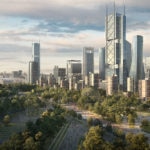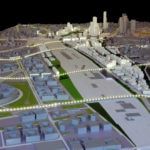'Madrid Nuevo Norte': An urban project for Madrid in the 21st century
A responsible urban development, designed by and for the citizens, that places people at its heart. A consensus project, in which all sides have worked and collaborated so that Madrid projects an image of the 21st century.

This is how 'Madrid Nuevo Norte’ defines itself. The project was unveiled today at the town hall of the Spanish capital city under the slogan 'Madrid’s Project, Everyone’s Project.' The event was attended by all the public and private parties involved in the project, which, through social and political consensus, have put an end to the stalemate that kept the project on hold for almost 25 years.
This new approach to urban regeneration will unite the city’s northernmost quarters, renewing and repurposing some strategic points, including the Chamartin railway station, which will be connected to the airport to become the city’s main transport hub. Sustainable mobility was a key element in the project’s new design, which prioritizes public transportation and neighborhood interconnectedness. Madrid Nuevo Norte is a publicly promoted initiative designed in collaboration with the cross-disciplinary team of Distrito Castellana Norte and leading international experts in urban planning, architecture, sustainability and mobility.
The project
The project’s design began with the definition of the large public infrastructures, such as traffic junctions, water and sanitation networks and the extensive public transport system, including transport hubs. It then continued with the layout of the main streets linking the city, with large north-south axes.
Historically, rail tracks have split Northern Madrid into two separate areas. The project envisages a series of structures to span this divide: (i) three bridges - Santo Domingo de la Calzada, Herrera Oria and Malmea -, (ii) a tunnel for road traffic and (iii) a pedestrian and cyclist footbridge that will connect the streets of Valverde and La Reina Bridge.
The layout of 'Madrid Nuevo Norte' streets and public spaces’ has been designed to ensure that people can enjoy them. Newly developed green areas have will integrate with already existing ones to form an extensive grid of parks, which will also span 15 kilometers of bike paths. This green corridor will connect the city with El Monte de El Pardo, the most important Mediterranean forest within the Community of Madrid and one of the best preserved in Europe.
The public facility policy, defined at a later stage of the project, envisages the public services to cover both the needs of both current residents and the new neighbors as they start moving into the area. The building and commercial areas have been designed taking into account the best practices and learning points of the world’s most relevant projects. The layout of the resulting business district and residential areas seeks to ensure seamless integration, prioritizing urban sustainability.
Madrid city council member for planning José Manuel Calvo opened the presentation conference saying that ‘Madrid Nuevo Norte’ will be the most important project in Madrid for the next 25 years. “A year ago, all the parties involved established the framework of understanding to resolve the urban divide that separates the northern part of the city. A year later, we all have agreed on an effective solution that prioritizes sustainability, public transport, green areas and the mixed use of spaces.” He also pointed out the importance of public housing, which will account for 20% of the total residential space, doubling the ratio stipulated by law.

View of 'Madrid Nuevo Norte' scale model.
This new project is the result of a complex technical work, which has required all parties involved to collaborate intensely. For Antonio Béjar, Chairman of Distrito Castellana Norte, the effort that has been undoubtedly worthwhile: "The fruit of this effort will become a benchmark for urban regeneration worldwide. In addition, the level of detail has never been as high as it is now, and all citizens can finally visualize the project. We are particularly proud of how this public-private collaboration effort has been coordinated. This is not an urban project spawning from real estate interests, but, as it could not have been otherwise, from the point of view of social interest. It is an example of how work can be carried out through consensus, to define a top level project.”
Antonio Béjar concluded his address pointing out that the planning and design stages have already concluded. "Now we will continue to work and collaborate in a determined and coordinated manner, to ensure that the administrative procedures, which are complex, can be completed within the established deadlines.”
According to the Minister of Public Works, José Luis Ábalos, the project stands as an example of how different territorial administrations, controlled by different political parties, should leave partisan interests aside when promoting projects that are beneficial for the cities.
Manuela Carmena, Mayor of Madrid, closed the ceremony by thanking everyone for the respect they have shown for the institutions, and emphasized the importance of consensus. “There were difficult times, but you have all worked to reach this consensus. The way to keep moving ahead is by listening to everyone and taking everyone’s views into account."